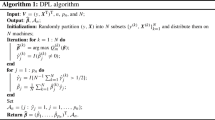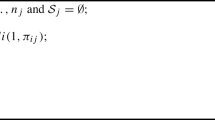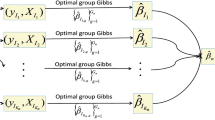Abstract
Massive data are often featured with high dimensionality as well as large sample size, which typically cannot be stored in a single machine and thus make both analysis and prediction challenging. We propose a distributed gridding model aggregation (DGMA) approach to predicting the conditional mean of a response variable, which overcomes the storage limitation of a single machine and the curse of high dimensionality. Specifically, on each local machine that stores partial data of relatively moderate sample size, we develop the model aggregation approach by splitting predictors wherein a greedy algorithm is developed. To obtain the optimal weights across all local machines, we further design a distributed and communication-efficient algorithm. Our procedure effectively distributes the workload and dramatically reduces the communication cost. Extensive numerical experiments are carried out on both simulated and real datasets to demonstrate the feasibility of the DGMA method.








Similar content being viewed by others
References
Ando T, Li K-C (2014) A model-averaging approach for high-dimensional regression. J Am Stat Assoc 109:254–265
Ando T, Li K-C (2017) A weight-relaxed model averaging approach for high dimensional generalized linear models. Ann Stat 45:2645–2679
Battey H, Fan J, Liu H, Lu J, Zhu Z (2018) Distributed testing and estimation under sparse high dimensional models. Ann Stat 46:1352–1382
Boyd S, Parikh N, Chu E, Peleato B, Eckstein J (2011) Distributed optimization and statistical learning via the alternating direction method of multipliers. Trends Mach Learn 3:1–122
Buckland ST, Burnham KP, Augustin NH (1997) Model selection: an integral part of inference. Biometrics 53:603–618
Burnham KP, Anderson DR (2003) Model selection and multimodel inference: a practical information-theoretic approach. Springer, New York
Chen X, Xie M (2014) A split-and-conquer approach for analysis of extraordinarily large data. Stat Sin 24:1655–1684
Chen X, Zhang Y, Li R, Wu X (2016) On the feasibility of distributed kernel regression for big data. IEEE Trans Knowl Data Eng 28:3041–3052
Chernozhukov V, Hansen C (2004) The impact of 401(k) participation on the wealth distribution: an instrumental quantile regression analysis. Rev Econ Stat 86:735–751
Dai D, Rigollet P, Zhang T (2012) Deviation optimal learning using greedy Q-aggregation. Ann Stat 40:1878–1905
Eklund J, Karlsson S (2007) Forecast combination and model averaging using predictive measures. Econ Rev 26:329–363
Fan J, Lv J (2008) Sure independence screening for ultrahigh dimensional feature space. J R Stat Soc B 70:849–911
Hansen BE (2007) Least squares model averaging. Econometrica 75:1175–1189
Hansen BE, Racine JS (2012) Jackknife model averaging. J Econ 167:38–46
Hjort NL, Claeskens G (2003) Frequentist model average estimators. J Am Stat Assoc 98:879–899
Hoeffding W (1963) Probability inequalities for sums of bounded random variables. J Am Stat Assoc 58:13–30
Hoeting JA, Madigan D, Raftery AE, Volinsky CT (1999) Bayesian model averaging: a turorial. Stat Sci 14:382–401
Jakovetic D, Xavier J, Moura JMF (2014) Fast distributed gradient methods. IEEE Trans Autom Control 59:1131–1146
Johnson R, Zhang T (2013) Accelerating stochastic gradient descent using predictive variance reduction. Adv Neural Inf Process Syst 26:315–323
Jordan MI, Lee JD, Yang Y (2019) Communication-efficient distributed statistical learning. J Am Stat Assoc 114:668–681
Kleiner A, Talwalkar A, Sarkar P, Jordan MI (2014) A scalable bootstrap for massive data. J R Stat Soc B 76:795–816
Lee JD, Liu Q, Sun Y, Taylor JE (2017) Communication-efficient sparse regression. J Mach Learn Res 18:1–30
Liang H, Zou G, Wan ATK, Zhang X (2011) Optimal weight choice for frequentist model average estimators. J Am Stat Assoc 106:1053–1066
Mateos G, Bazerque JA, Giannakis GB (2010) Distributed sparse linear regression. IEEE Trans Signal Process 58:5262–5276
Nair V, Hinton GE (2010) Rectified linear units improve restricted boltzmann machines. In: ICML’10 Proceedings of the 27th international conference on international conference on machine learning, pp 807–814
Newbold P, Granger CWJ (1974) Experience with forecasting univariate time series and the combination of forecast (with discussion). J R Stat Soc Ser A 137:131–165
Raftery AE, Madigan D, Hoeting JA (1997) Bayesian model averaging for linear regression models. J Am Stat Assoc 92:179–191
Rosenblatt J, Nadler B (2016) On the optimality of averaging in distributed learning. Inf Inference 5:379–404
Shamir O, Srebro N, Zhang T (2014) Communication-efficient distributed optimization using an approximate Newton-type method. Proc Int Conf Mach Learn 32:1000–1008
Shang Z, Cheng G (2017) Computational limits of a distributed algorithm for smoothing spline. J Mach Learn Res 18:1–37
Shvachko K, Kuang H, Radia S, Chansler R (2010) The hadoop distributed file system. In: IEEE 26th symposium on mass storage systems and technologies, pp 1–10
van de Geer SA (2008) High-dimensional generalized linear models and the lasso. Ann Stat 36:614–645
Wan ATK, Zhang X, Zou G (2010) Least squares model averaging by Mallows criterion. J Econ 156:277–283
Wang J, Kolar M, Srebro N, Zhang T (2017) Efficient distributed learning with sparsity. Proc Mach Learn Res 70:3636–3645
Zaharia M, Chowdhury M, Franklin MJ, Shenker S, Stoica I (2010) Spark: cluster computing with working sets. In: Proceedings of the 2nd USENIX conference on hot topics in cloud computing, pp 10–10
Zhang C, Lee H, Shin K (2012) Efficient distributed linear classification algorithms via the alternating direction method of multipliers. Proc Int Conf Artif Intell Stat 22:1398–1406
Zhang X, Zou G, Liang H (2014) Model averaging and weight choice in linear mixed-effects models. Biometrika 101:205–218
Zhang Y, Duchi J, Jordan JC, Wainwright MJ (2013) Information-theoretic lower bounds for distributed statistical estimation with communication constraints. Adv Neural Inf Process Syst 26:2328–2336
Zhang Y, Duchi J, Wainwright M (2013) Divide and conquer kernel ridge regression. Conf Learn Theory 30:1–26
Zhao T, Cheng G, Liu H (2016) A partially linear framework for massive heterogeneous data. Ann Stat 44:1400–1437
Acknowledgements
We would like to thank the two referees and Associate Editor for many insightful comments that greatly improved the paper. Liu’s research was partly supported by the National Natural Science Foundation of China (11971362), Yin’s research was partly supported by the Research Grants Council of Hong Kong (17308321), and Wu’s research was partly supported by the National Natural Science Foundation of China (12071483).
Author information
Authors and Affiliations
Corresponding author
Additional information
Publisher's Note
Springer Nature remains neutral with regard to jurisdictional claims in published maps and institutional affiliations.
Supplementary Information
Below is the link to the electronic supplementary material.
Supplementary Material
The supplementary material available online contains some theoretical results. (pdf 136KB)
Rights and permissions
About this article
Cite this article
He, B., Liu, Y., Yin, G. et al. Model aggregation for doubly divided data with large size and large dimension. Comput Stat 38, 509–529 (2023). https://doi.org/10.1007/s00180-022-01242-3
Received:
Accepted:
Published:
Issue Date:
DOI: https://doi.org/10.1007/s00180-022-01242-3




